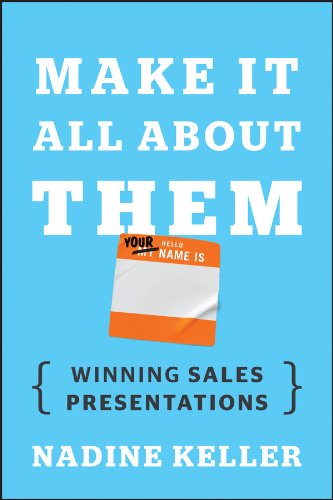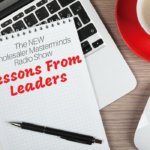Talk about a small world.
Our wholesaling universe is just that.
But have you fallen victim to myths and traditions handed down to you from a previous wholesaling generation?
 Nadine Kellers’s entire career has been focused on helping financial services sales people be more effective. As the founder of Precision Sales Coaching and Training, she has touched all aspects of the sales cycle from prospecting to final sales presentations to relationship development and cross-selling.
Nadine Kellers’s entire career has been focused on helping financial services sales people be more effective. As the founder of Precision Sales Coaching and Training, she has touched all aspects of the sales cycle from prospecting to final sales presentations to relationship development and cross-selling.
Much of her recent work has been on redesigning finals presentations in the retirement space. An output of that work is her book “Make It All About Them: Winning Sales Presentations”.
To inquire about booking Nadine Keller for your next event through Wholesaler Masterminds Speakers Bureau contact us at info@wholesalermasterminds.com
Are you victim to myths and traditions handed down to you from a previous generation?
While “Make It All About Them: Winning Sales Presentations” focuses mainly on sales presentations, the premise is that sales people have been handing down some traditions from generation to generation that actually work against them:
It Is All About Us
One fundamental belief that needs to be debunked is that the sales discussion should be about the salesperson’s products and services. In truth, the discussion always has to be centered on the client. This is a tricky one because most wholesalers think that they do in fact focus on the needs of the advisor. When advisors are asked however, they say this is rarely the case. This is because we have been conditioned on both sides that sales meetings, by their nature, are about the wholesaler telling advisors about their products and services – and how they are different.
The subtle, although significant, difference is that it should not be about the wholesaler and their products, but rather how their product and services meet the advisor’s – and the advisor’s clients’ needs. This of course requires a deep understanding of what those needs are.
What to do about it:
Always start with the advisor’s needs (to provide context for your services) whether it be a first call (where you are asking questions to understand her needs) or subsequent calls and proposals where you are confirming the needs and providing context for your recommendations. Every contact, in person or on “paper”, begins with them.
Introducing Yourself with Your Name, Title, and Numbers of Years You Have Been Someplace
For some reason there is a universal code in corporate America for how people introduce themselves. It is typically name, title and number of years you have been somewhere. Rarely do clients and prospects care about any of this. Introductions set the tone of the meeting and they provide an opportunity to connect as human beings.
What to do about it
Rather than stating your title, let a prospect know what your role is, and what you will do for them once they are your client. For example, “I am the person who will be responsible for the day-to-day management of your account.” And rather than telling them the number of years you have been some place, use that valuable time to form a connection. It can be as simple as “What I love about what I do is …”, or “I always love to visit Chicago as my all-time favorite restaurant is here…”
Jargon Makes Us Sound Smarter
Early in our careers using industry jargon helps us to build credibility, it is almost like there is a secret language that makes us part of a club. We hang on to this as we advance in our careers, which can be detrimental in a sales environment.
We know from research that people who use jargon are considered to be less trustworthy. We also know that even if a word is familiar to someone, but he doesn’t use it frequently, he will need a few seconds to process it. He then drops out of the conversation for a second or two and may not be able to regain the same level of listening again.
Refraining from jargon is hard! It has become such a part of our vernacular, that we often cannot even recognize our jargon as jargon. While wholesalers and advisors share some industry jargon, the advisor’s clients often do not. Being sensitive to this, and limiting your use of jargon, will in turn help advisors limit their use of jargon with their clients.
What to do about it
Assign a jargon police. When we coach deals I will often ask someone to be responsible for listening as a prospect would, being sensitive to any company or industry jargon that might be confusing.
When discussing your solutions, think about choosing language that the end-user is likely to use when he/she wakes up and worries about his problem in the middle of the night. I call this “3 o’clock in the morning language”. For example it is unlikely that anyone would wake up in the middle of the night thinking “I need guaranteed income in retirement.” Rather, they are likely thinking about things like “I don’t want to be a burden to my children!” or “I need to figure out a way that I won’t run out of money when I retire…” Not only does this take the jargon out of the conversation, but it also helps to connect with the emotions that ultimately will drive the buying decision.
The Fewer Slides The Better
This one is very specific to the materials we use in a sales presentation, or any other presentation for that matter. In the early days of PowerPoint, the presenter would sit on a slide loaded with bullet points and talk to each one. Those days are over. Attention spans are shorter than ever before, and we need to keep things moving in order to keep our audience’s attention.
What to do about it
Highly visual slides, with fewer words, will help to ensure that your slides are supporting your connection with your audience – not distracting from it. Limit each slide to one thought and move through them quickly. Think about slides as a tool to help illustrate your story, rather than tell your story. If your slides can stand alone and tell the story without you there is something wrong with your slides.
Written by Nadine Keller


 Converting Simple Connections to Meaningful Relationships on LinkedIn with Kim Peterson Stone
Converting Simple Connections to Meaningful Relationships on LinkedIn with Kim Peterson Stone Why Do a Few Highly Successful Wholesalers Consistently Outperform Their Peers? with Anthony Iannarino
Why Do a Few Highly Successful Wholesalers Consistently Outperform Their Peers? with Anthony Iannarino Lessons From Leaders #5: Interview with Jeff Carlin, CFA at Nuveen
Lessons From Leaders #5: Interview with Jeff Carlin, CFA at Nuveen Lessons From Leaders #9: Successfully Moving Your Distribution Career Forward with Kathy Freeman
Lessons From Leaders #9: Successfully Moving Your Distribution Career Forward with Kathy Freeman Is Grit a Wholesaler’s Most Important Attribute? with Dr. Eric Frazer
Is Grit a Wholesaler’s Most Important Attribute? with Dr. Eric Frazer